 By Bob Currie, Recreational Boating Safety Specialist
By Bob Currie, Recreational Boating Safety Specialist
U. S. Coast Guard Auxiliary Station Galveston Flotilla
Every year at Coast Guard Station Galveston the base hosts Safety at Sea for the Sea Scouts, a division of the Boy Scouts of America. There are several activities in which the Sea Scouts participate, including participating in the use of pyrotechnic visual distress signals, including smoke flares, handheld flares, pistol fired flares, and rockets. Every Sea Scout gets to fire each type of flare and rocket. This column will discuss the various types of visual distress signals and the requirements for carrying and using them.
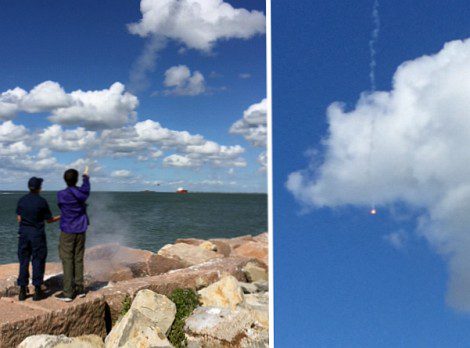 Parachute rocket fired over the Houston Ship Channel (Photos by Bob Currie)
Parachute rocket fired over the Houston Ship Channel (Photos by Bob Currie)
U.S. Coast Guard regulations require that vessels operating on coastal waters of the United States, the Great Lakes, and territorial seas, as well as those inland waters connected directly to coastal waters, the Great Lakes, and territorial seas from the point of connection to the point at which the waterway narrows to less than two nautical miles wide, must be equipped with U.S. Coast Guard approved visual distress signals. Using these criteria, almost all of Galveston East Bay falls under the requirement for visual distress signals (VDS). Recreational boats 16 feet and over are required to carry the following working and unexpired (if expiration is shown) visual distress signals:
- Three day and three night pyrotechnic devices, or
- One day non-pyrotechnic device (flag) and one night non-pyrotechnic device (auto SOS light), or
- A combination of 1) and 2); Example: One flag and three night pyrotechnic devices
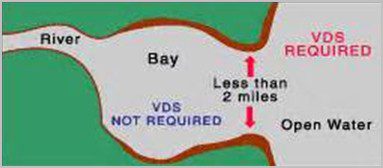
Recreational boats less than 16 feet on coastal waters or the Great Lakes need only carry night visual distress signals when operating from sunset to sunrise. Texas has no further requirements than those required by the Coast Guard. When purchasing pyrotechnic devices, note that some such devices, such as orange smoke devices, are for daytime use only, and thus only meet the daytime requirement of the regulation.
It is recommended, but not required, that boats operating on inland waters should have some means of making a suitable day and night visual distress signal. The number and type of signals is best judged by considering conditions under which the boat will be operating.
The following vessels are not required to carry day signals, but must carry night signals when operating from sunset to sunrise:
- Recreational boats less than 16 feet in length.
- A vessel participating in any organized marine parade, regatta, race, or similar event.
- A manually propelled boat.
- Sailboats less than 26 feet of completely open construction and not equipped with propulsion machinery.
Alert Signals vs. Locate Signals
Pyrotechnic Devices
Must be Coast Guard Approved, in serviceable condition and readily accessible. If they meet the day/night requirement, you need three flares, minimum. They are stamped with an expiration date of 42 months (3 1/2 years from the date they were manufactured). You can keep them after they are expired as extra equipment because they usually will still work, but you can’t count them as part of the Coast Guard’s requirements in a Vessel Safety Check inspection. Uninspected passenger vessels (UPVs) may not have any expired pyrotechnic devices aboard.
“Alert” Signals Draw Attention to Your Emergency
Meteor flares are propelled by black powder and launched from a pistol-shaped handheld holder. They reach an altitude of 375′ to 500′ and burn for 7-8 seconds. Rocket-propelled SOLAS parachute flares rise to 1,000′ and burn for 40 seconds. 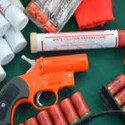 Fire aerial flares after you have sighted or heard a potential rescue vessel. To attract their attention to your distress situation, the U.S. Coast Guard recommends that you fire two aerial flares – one immediately after the other – so rescuers can confirm the sighting and the direction of the signal.
Fire aerial flares after you have sighted or heard a potential rescue vessel. To attract their attention to your distress situation, the U.S. Coast Guard recommends that you fire two aerial flares – one immediately after the other – so rescuers can confirm the sighting and the direction of the signal.
“Locate” Handheld Flares Show Rescuers Where You Are
Handheld flares burn for one to two minutes, and are for both daytime and nighttime use. Orange SOLAS smoke flares are for daytime use only, and are the best way for offshore boaters to show their location to rescuers searching in a Coast Guard helicopter or fixed wing aircraft. They float on the water’s surface and emit a dense orange cloud for three to four minutes. Handheld signal flares are intended as homing signals to pinpoint your position. The surface-to-surface sighting range on water is approximately three to five miles, depending on boat elevation. If a rescuer is five miles away and running at 20 miles per hour, it will take 15 minutes to reach you. Therefore, you should have at least 12 minutes (total burn time) of signals onboard to maintain a strong homing signal until help arrives.
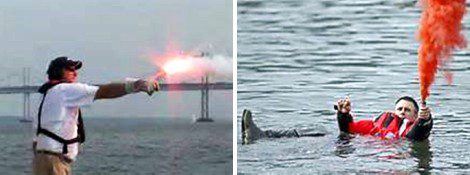
Non-Pyrotechnic Devices
An orange distress flag is 3′ x 3′ square with a black square and ball on an orange background. It’s for daytime use only, and is less effective at catching attention than a flare, except that it is not limited by a short burning time. An electric distress signal is approved for night only. The electric distress signal below flashes SOS in Morse code. The LED light is very bright, but it is not approved for daytime use. The electric distress signal has no expiration date, but keep in mind that batteries lose their strength during storage. I remove the batteries from my electric distress signal during winter as batteries can degrade and leak acid when stored inside the electric distress signal. I store my boat key in the same bag as my electric distress signal so that I know to install the batteries when I am going out on the water.
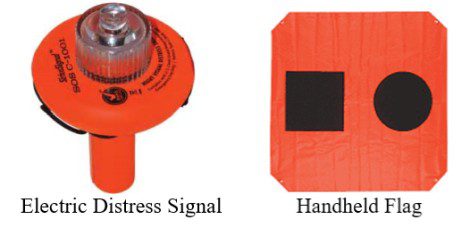
Whatever combination of visual distress signals you acquire for your boat, remember that the devices must be Coast Guard approved, not expired, and be readily accessible. You should instruct everyone aboard as to where the devices are stored. When I interviewed the survivor of a boat that swamped and capsized, I found that the boat encountered troubles well within sight of other vessels. The captain became incapacitated, and the passengers neither knew how to work the boat’s marine VHF/FM radio nor where the visual distress signals were located. As a result, several vessels passed them by while their boat sank and eventually capsized. A passing tanker finally realized that the boat was in trouble and launched a lifeboat to assist them.
Summary
Visual distress signals are an important part of your safety plan and in most cases are required by the Coast Guard, depending on the length and type of vessel as well as where you operate the vessel. Be sure to follow the rules for having visual distress signals, and be especially aware of the expiration date for each type of signal.
[BC: Mar-5-2024]

 Posted in
Posted in 























